Hemp: Difference between revisions
No edit summary |
|||
| Line 390: | Line 390: | ||
</ref>. |
</ref>. |
||
Vermont and North Dakota have passed laws enabling hemp licensure. Both states are waiting for permission to grow hemp from the Drug Enforcement Agency (DEA). Currently, North Dakota representatives are pursuing legal measures to force DEA approval.<ref>http://www.votehemp.com/legal_cases_ND.html</ref> |
Vermont and North Dakota have passed laws enabling hemp licensure. Both states are waiting for permission to grow hemp from the Drug Enforcement Agency (DEA). Currently, North Dakota representatives are pursuing legal measures to force DEA approval.<ref name=North Dakota DEA>[http://www.votehemp.com/legal_cases_ND.html North Dakota Case]</ref> |
||
== Future of hemp == |
== Future of hemp == |
||
Revision as of 15:04, 22 February 2009
This article needs additional citations for verification. (October 2008) |
- This article is about the cultivation and uses of industrial hemp, not its psychoactive variant, Cannabis (drug). For the biology of the plant, see Cannabis. For other uses of the word hemp, see Hemp (disambiguation).
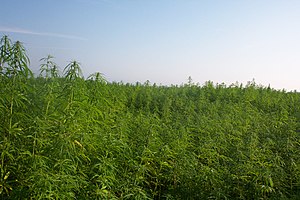
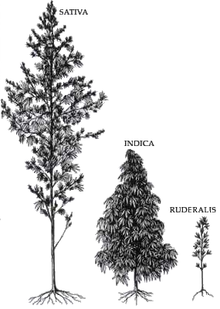

Hemp (from Old English hænep, see cannabis (etymology)) is the common name for plants of the entire genus Cannabis, although the term is often used to refer only to Cannabis strains cultivated for industrial (non-drug) use.
Industrial hemp has many uses, including paper, textiles, biodegradable plastics, health food, and fuel.[1] It is one of the fastest growing biomasses known,[citation needed] and one of the earliest domesticated plants known.[2] It also runs parallel with the "Green Future" objectives that are becoming increasingly popular. Hemp requires little to no pesticides,[3] no herbicides,[4] controls erosion of the topsoil, and produces oxygen. Furthermore, hemp can be used to replace many potentially harmful products, such as tree paper (the processing of which uses chlorine bleach, which results in the waste product polychlorinated dibensodioxins, popularly known as dioxins, which is carcinogenic, and contributes to deforestation), cosmetics, and plastics, most of which are petroleum-based and do not decompose easily. The strongest chemical needed to whiten the already light hemp paper is non-toxic hydrogen peroxide. [5]
Cannabis sativa L. subsp. sativa var. sativa is the variety grown for industrial use in Europe, Canada, and elsewhere, while C. sativa subsp. indica generally has poor fiber quality and is primarily used for production of recreational and medicinal drugs. The major difference between the two types of plants is the appearance and the amount of Δ9-tetrahydrocannabinol (THC) secreted in a resinous mixture by epidermal hairs called glandular trichomes. Strains of Cannabis approved for industrial hemp production produce only minute amounts of this psychoactive drug, not enough for any physical or psychological effects. Typically, Hemp contains below 0.3% THC, while Cannabis grown for marijuana can contain anywhere from 6 or 7 % to 20% or even more.
Industrial Hemp is produced in many countries around the world. Major producers include Canada, France, and China. While more hemp is exported to the United States than to any other country, the United States Government does not distinguish between marijuana and the non-psychoactive Cannabis used for industrial and commercial purposes.
Uses
Hemp is used for a wide variety of purposes, including the manufacture of cordage of varying tensile strength, clothing, and nutritional products. The bast fibers can be used in 100% hemp products, but are commonly blended with fibers such as flax, cotton or silk, for apparel and furnishings, most commonly at a 55%/45% hemp/cotton blend. The inner two fibers of hemp are more woody, and are more often used in non-woven items and other industrial applications, such as mulch, animal bedding and litter. The oil from the fruits ("seeds") dries on exposure to air (similar to linseed oil) and is sometimes used in the manufacture of oil-based paints, in creams as a moisturising agent, for cooking, and in plastics. Hemp seeds have been used in bird seed mix.[6]
Material
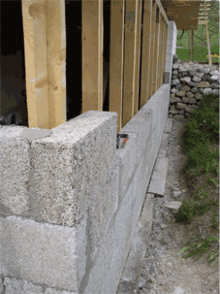
In Europe and China, hemp fibers are increasingly used to strengthen concrete, and in other composite materials for many construction and manufacturing applications. Hempcrete is used as a construction material containing hemp hurds, especially in France. Mercedes-Benz uses a "biocomposite" composed principally of hemp fiber for the manufacture of interior panels in some of its automobiles.
Food
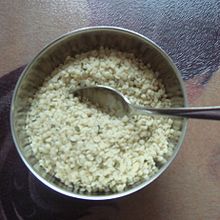
Hemp seeds contain all the essential amino acids and essential fatty acids necessary to maintain healthy human life[7]. The seeds can be eaten raw, ground into a meal, sprouted, made into hemp milk (akin to soy milk), prepared as tea, and used in baking. The fresh leaves can also be eaten in salads. Products range from cereals to frozen waffles, hemp tofu to nut butters. A few companies produce value added hemp seed items that include the seed oils, whole hemp grain (which is sterilized as per international law), hulled hemp seed (the whole seed without the mineral rich outer shell), hemp flour, hemp cake (a by-product of pressing the seed for oil) and hemp protein powder. Hemp is also used in some organic cereals, for non-dairy milk[8] somewhat similar to soy and nut milks, and for non-dairy hemp "ice cream."[9]
Within the UK, the Department for Environment, Food and Rural Affairs (Defra) has treated hemp as purely a non-food crop. Seed appears on the UK market as a legal food product, and cultivation licenses are available for this purpose. In North America, hemp seed food products are sold in large volumes, particularly from Canada to the USA, and typically in health food stores or through mail order.[10]
Nutrition
| Calories/100 g | 567 |
| Protein | 30.6 |
| Carbohydrate | 10.9 |
| Dietary fiber | 6 |
| Fat | 47.2 |
| Saturated fat | 5.2 |
| Palmitic 16:0 | 3.4 |
| Stearic 18:0 | 1.5 |
| Monounsaturated fat | 5.8 |
| Oleic 18:1 (Omega-9) | 5.8 |
| Polyunsaturated fat | 36.2 |
| Linoleic 18:2 (Omega-6) | 27.6 |
| Linolenic 18:3 (Omega-3) | 8.7 |
| Linolenic 18:3 (Omega-6) | 0.8 |
| Cholesterol | 0 mg |
| Moisture | 5 |
| Ash | 6.6 |
| Vitamin A (B-Carotene) | 4 IU |
| Thiamine (Vit B1) | 1 mg |
| Riboflavin (Vit B2) | 1 mg |
| Vitamin B6 | 0 mg |
| Niacin (Vit B3) | 0 mg |
| Vitamin C | 1.0 mg |
| Vitamin D | 0 IU |
| Vitamin E | 9 IU |
| Sodium | 9 mg |
| Calcium | 74 mg |
| Iron | 4.7 mg |
| Source: [4] |
About 30–35% of the weight of hempseed is an edible oil that contains about 80% as essential fatty acids (EFAs); i.e., linoleic acid, omega-6 (LA, 55%), alpha-linolenic acid, omega-3 (ALA, 22%), in addition to gamma-linolenic acid, omega-6 (GLA, 1–4%) and stearidonic acid, omega-3 (SDA, 0–2%). Hempseed also contains about 20% of a highly-digestible protein, where 1/3 is edestin and 2/3 are albumins. Its amino acid profile is close to "complete" when compared to more common sources of proteins such as meat, milk, eggs and soy.[11] The proportions of linoleic acid and alpha-linolenic acid in one tablespoon (15 ml) per day of hempseed oil easily provides human daily requirements for EFAs. Unlike flaxseed oil, hempseed oil can be used continuously without developing a deficiency or other imbalance of EFAs. This has been demonstrated in a clinical study, where the daily ingestion of flaxseed oil decreased the endogenous production of GLA.[12] Highly unsaturated oils, and especially poor quality oils, can spontaneously oxidize and turn rancid within a short period of time when they are not stored properly; i.e., in a cool/cold, dark place, preferably in a dark glass bottle. Hempseed oil can be frozen for longer periods of storage time, without a risk of breaking glass containers . Preservatives (antioxidants) are not necessary for high quality oils that are stored properly. Highly unsaturated oils are not suitable for frying, although grapeseed oil is a highly unsaturated oil that is commonly used in deep frying, primarily because of its high smoking point. Hempseed oil is primarily used as a food oil and dietary supplement,[10] and has been shown to relieve the symptoms of eczema (atopic dermatitis).[13]
Hempseed is an adequate source of calcium and iron. Iron deficiency is the leading nutrient deficiency world wide. Whole, toasted hempseeds are also a good source of phosphorus, magnesium, zinc, copper and manganese.
Hempseed contains no gluten and may be a healthful food for people with celiac disease.
Medicine
Hemp seed oil has anti-inflammatory properties.[citation needed]
Fiber

The fiber is one of the most valuable parts of the hemp plant. It is commonly called bast, which refers to the fibers that grow on the outside of the woody interior of the plant's stalk, and under the outer most part (the bark). Bast fibers give the plants strength, which is especially true with the hemp plant. Hemp fibers can be 0.91 m (3 ft) to 4.6 m (15 ft) long, running the length of the plant. Depending on the processing used to remove the fiber from the stem, the hemp may naturally be creamy white, brown, gray, black or green.[citation needed]
The use of hemp for fiber production has declined sharply over the last two centuries, but before the industrial revolution, hemp was a popular fiber because it is strong and grows quickly; it produces 250% more fiber than cotton and 600% more fiber than flax when grown on the same land.[citation needed] Hemp has been used to make paper. The Declaration of Independence was drafted by Jefferson on hemp paper.[14] It was used to make canvas, and the word canvas derives from cannabis.[15][16] Hemp was very popular as it had many uses. Abaca or Manila replaced its use for rope. Burlap, made from jute, took over the sacking market. The paper industry began using wood pulp. The carpet industry switched over to wool, sisal, and jute, then nylon. Netting and webbing applications were taken over by cotton and synthetics. The world hemp paper pulp production was believed to be around 120,000 tons per year in 1991 which was about 0.05 % of the world's annual pulp production volume.[17]

In 1916, US Department of Agriculture chief scientists Lyster H. Dewe, and Jason L. Merrill created paper made from hemp pulp, which they concluded was "favorable in comparison with those used with pulp wood."[18] [5] Jack Herer later summarized the findings of the bulletin in his book "The Emperor Wears No Clothes."[19] Herer wrote:
In 1916, USDA Bulletin No. 404, reported that one acre of cannabis hemp, in annual rotation over a 20-year period, would produce as much pulp for paper as 4.1 acres (17,000 m2) of trees being cut down over the same 20-year period. This process would use only 1/4 to 1/7 as much polluting sulfur-based acid chemicals to break down the glue-like lignin that binds the fibers of the pulp, or none at all using soda ash. The problem of dioxin contamination of rivers is avoided in the hemp paper making process, which does not need to use chlorine bleach (as the wood pulp paper making process requires) but instead safely substitutes hydrogen peroxide in the bleaching process. ... If the new (1916) hemp pulp paper process were legal today, it would soon replace about 70% of all wood pulp paper, including computer printout paper, corrugated boxes and paper bags.
[citation needed][citation needed]
New technology has allowed for more environmentally-friendly paper production from wood pulp, though the production of wood pulp paper still claims the one of the highest CO2 emissions by industry (second only to concrete production)[citation needed]. The recovery boiler was invented in the early 1930s. The first recovery boilers were commissioned to wood-pulp mills during the mid-1930s,[20] ECF (Elemental Chlorine Free),[21] or TCF (Total chlorine Free) bleaching, better fiber filters etc. has created less of a demand for alternative raw materials. Hemp is currently of little significance as raw material for paper; however, it is scarcely grown in the developed world. The long-term price for pulpwood has been low compared with any alternative except recycled paper. [22]
More about wood pulp technology in bleaching of wood pulp.
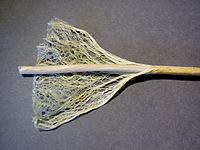
The decision of the United States Congress to pass the 1937 Marijuana Tax Act was based in part on testimony derived from articles in newspapers owned by William Randolph Hearst, who, some authors stress, had significant financial interests in the forest industry, which manufactured his newsprint.
The background material also included that from 1880 to 1933 the hemp grown in the United States had declined from 15,000 to 1,200 acres (4.9 km2), and that the price of line hemp had dropped from $12.50 per pound in 1914 to $9.00 per pound in 1933.[23][24] In 1935, however, hemp would also make a significant rebound.[24] Hearst began a campaign against hemp, and published stories in his newspapers associating hemp with marijuana[25] and attacking marijuana usage.[26] As a result of the act, the production and use of hemp was discontinued.
Characteristics of hemp fibre are its superior strength and durability, resistance to ultraviolet light and mold, comfort and good absorbency (8%).[citation needed] The original Levi Strauss jeans were made from lightweight hemp canvas. Hemp rope is notorious for breaking due to rot as the capillary effect of the rope-woven fibres tended to hold liquid at the interior, while seeming dry from the outside.[27] Hemp rope used in the age of sailing-ships was protected by tarring, a labor-intensive process (and source of the Jack Tar nickname for sailors). Hemp rope was phased out when Manila, which does not require tarring, became available.
There is a niche market for hemp paper, but the cost of hemp pulp is approximately six times that of wood pulp,[17] mostly due to the small size and outdated equipment of the few hemp processing plants in the Western world. Hemp pulp is bleached with hydrogen peroxide, which can also be used for wood pulp. Kenaf is another fast-growing plant which can be used as a replacement for wood pulp. Kenaf paper has been produced in commercial quantities.[28]
A modest hemp industry exists. Recent developments in processing have made it possible to soften coarse fibers to a wearable level. The Hempest is an example of a clothing store that specializes in hemp clothing.
Weed control
Hemp, because of its height, dense foliage and its high planting density as a crop, is a very effective and long used method of killing tough weeds in farming.[29] Using hemp this way can help farmers avoid the use of herbicides, to help gain organic certification and to gain the benefits of crop rotation per se.
Fuel
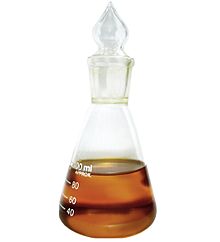
Biofuels such as biodiesel and alcohol fuel can be made from the oils in hemp seeds and stalks, and the fermentation of the plant as a whole, respectively. Filtered hemp oil can be used directly to power diesels. The inventor of the diesel engine, Rudolf Diesel, used hemp oil to power his new engine, and assumed that it would be run in the future on hemp oil. As diesel oil is the very same oil used for home heating, hemp oil could be the renewable substitute for that. --Jacob Silver (talk) 00:32, 19 February 2009 (UTC)The energy from hemp may be high based on acreage or weight, but can be low based on the volume of the light weight harvested hemp.[citation needed] It does, however, produce more energy per acre per year than corn, sugar, flax, or any other crop currently grown for ethanol or biodiesel.[citation needed]
Henry Ford grew industrial hemp on his estate after 1937,[30] possibly to prove the cheapness of methanol production at Iron Mountain. He made plastic cars with wheat straw, hemp and sisal. (Popular Mechanics, Dec. 1941, "Pinch Hitters for Defense.") In 1892, Rudolph Diesel invented the diesel engine, which he intended to fuel "by a variety of fuels, especially vegetable and seed oils."[31][32][33][34]
Cultivation

Millennia of selective breeding have resulted in varieties that look quite different. Also, breeding since circa 1930 has focused quite specifically on producing strains which would perform very poorly as sources of drug material. Hemp grown for fibre is planted closely, resulting in tall, slender plants with long fibres. Ideally, according to Britain's Department for Environment, Food and Rural Affairs, the herb should be harvested before it flowers. This early cropping is done because fibre quality declines if flowering is allowed and, incidentally, this cropping also pre-empts the herb's maturity as a potential source of drug material. However, in these strains of industrial hemp the tetrahydrocannabinol (THC) content would have been very low regardless.

The name Cannabis is the genus and was the name favoured by the 19th century medical practitioners who helped to introduce the herb's drug potential to modern English-speaking consciousness. Cannabis for non-drug purposes (especially ropes and textiles) was then already well known as hemp.
The name "marijuana" is Spanish in origin and associated almost exclusively with the herb's drug potential.
Historical cultivation
While the fibre has been grown for millennia in Asia and the Middle East, commercial production of hemp in the West took off in the eighteenth century. Due to colonial and naval expansion of the era, economies needed large quantities of hemp for rope and oakum. The endless European Wars, and ever expanding naval fleets, all used the material. To this end, the young Republic of America became a large hemp producer. The Gulf and Carolina states had very large hemp industries. In fact the market was second only to cotton fibre. Machinery was invented in the United States for producing hemp fibre. An unpleasant task performed by prison labour was the manufacture of rope and boat caulking. Before the age of nylon rope, hemp rope had a short lifetime and was ever in need of replacement. In the 19th century it was cultivated by binders.
From the 1881 Household Cyclopedia:
- The soils most suited to the culture of this plant are those of the deep, black, putrid vegetable kind, that are low, and rather inclined to moisture, and those of the deep mellow, loamy, or sandy descriptions. The quantity of produce is generally much greater on the former than on the latter; but it is said to be greatly inferior in quality. It may, however, be grown with success on lands of a less rich and fertile kind by proper care and attention in their culture and preparation.
- In order to render the grounds proper for the reception of the crop, they should be reduced into a fine mellow state of mould, and be perfectly cleared from weeds, by repeated ploughings. When it succeeds grain crops, the work is mostly accomplished by three ploughings, and as many harrowings: the first being given immediately after the preceding crop is removed, the second early in the spring, and the last, or seed earth, just before the seed is to be put in. In the last ploughing, well rotted manure, in the proportion of fifteen or twenty, or good compost, in the quantity of twenty-five or thirty-three horse-cart loads, should be turned into the land; as without this it is seldom that good crops can be produced. The surface of the ground being left perfectly flat, and as free from furrows as possible; as by these means the moisture is more effectually retained, and the growth of the plants more fully promoted.
- It is of much importance in the cultivation of hemp crops that the seed be new, and of a good quality, which may in some measure be known by its feeling heavy in the hand, and being of a bright shining color.
- The proportion of seed that is most commonly employed, is from two to three bushels [per acre], according to the quality of the land; but, as the crops are greatly injured by the plants standing too closely together, two bushels, or two bushels and a half may be a more advantageous quantity.
- As the hemp plant is extremely tender in its early growth, care should be taken not to put the seed into the ground at so early a period, as that it may be liable to be injured by the effects of frost; nor to protract the sowing to so late a season as that the quality of the produce may be effected. The best season, on the drier sorts of land in the southern districts, is as soon as possible after the frosts are over in April; and, on the same descriptions of soil, in the more northern ones, towards the close of the same month or early in the ensuing one.
- The most general method of putting crops of this sort into the soil is the broadcast, the seed being dispersed over the surface of the land in as even a manner as possible, and afterwards covered in by means of a very light harrowing. In many cases, however, especially when the crops are to stand for seed, the drill method in rows, at small distances, might be had recourse to with advantage; as, in this way, the early growth of the plants would be more effectually promoted, and the land be kept in a more clean and perfect state of mould, which are circumstances of importance in such crops. In whatever method the seed is put in, care must constantly be taken to keep the birds from it for some time afterwards.
- This sort of crop is frequently cultivated on the same piece of ground for a great number of years, without any other kind intervening; but, in such cases, manure must be applied with almost every crop, in pretty large proportions, to prevent the exhaustion that must otherwise take place. It may be sown after most sorts of grain crops, especially where the land possesses sufficient fertility, and is in a proper state of tillage.

- As hemp, from its tall growth and thick foliage, soon covers the surface of the land, and prevents the rising of weeds, little attention is necessary after the seed has been put into the ground, especially where the broadcast method of sowing is practised; but, when put in by the drill machine, a hoeing or two may be had recourse to with advantage in the early growth of the crop.
- In the culture of this plant, it is particularly necessary that the same piece of land grows both male and female, or what is sometimes denominated simple hemp. The latter kind contains the seed.
- When the grain is ripe (which is known by its becoming of a whitish-yellow color, and a few of the leaves beginning to drop from the stems); this happens commonly about thirteen or fourteen weeks from the period of its being sown, according as the season may be dry or wet (the first sort being mostly ripe some weeks before the latter), the next operation is that of taking it from the ground; which is effected by pulling it up by the roots, in small parcels at a time, by the hand, taking care to shake off the mould well from them before the handsful are laid down. In some districts, the whole crop is pulled together, without any distinction being made between the different kinds of hemp; while, in others, it is the practice to separate and pull them at different times, according to their ripeness. The latter is obviously the better practice; as by pulling a large proportion of the crop before it is in a proper state of maturity, the quantity of produce must not only be considerably lessened, but its quality greatly injured by being rendered less durable.
- After being thus pulled, it is tied up in small parcels, or what are sometimes termed baits.
- Where crops of this kind are intended for seeding, they should be suffered to stand till the seed becomes in a perfect state of maturity, which is easily known by the appearance of it on inspection. The stems are then pulled and bound up, as in the other case, the bundles being set up in the same manner as grain, until the seed becomes so dry and firm as to shed freely. It is then either immediately threshed out upon large cloths for the purpose in the field, or taken home to have the operation afterwards performed.
- The hemp, as soon as pulled, is tied up in small bundles, frequently at both ends.
- It is then conveyed to pits, or ponds of stagnant water, about six or eight feet in depth, such as have a clayey soil being in general preferred, and deposited in beds, according to their size, and depth, the small bundles being laid both in a straight direction and crosswise of each other, so as to bind perfectly together; the whole, being loaded with timber, or other materials, so as to keep the beds of hemp just below the surface of the water.
- It is not usual to water more than four or five times in the same pit, until it has been filled with water. Where the ponds are not sufficiently large to contain the whole of the produce at once, it is the practice to pull the hemp only as it can be admitted into them, it being thought disadvantageous to leave the hemp upon the ground after being pulled. It is left in these pits four, five, or six days, or even more, according to the warmth of the season and the judgment of the operator, on his examining whether the hempy material readily separates from the reed or stem; and then taken up and conveyed to a pasture field which is clean and even, the bundles being loosened and spread out thinly, stem by stem, turning it every second or third day, especially in damp weather, to prevent its being injured by worms or other insects. It should remain in this situation for two, three, four, or more weeks, according to circumstances, and be then collected together when in a perfectly dry state, tied up into large bundles, and placed in some secure building until an opportunity is afforded for breaking it, in order to separate the hemp. By this means the process of grassing is not only shortened, but the more expensive ones of breaking, scutching, and bleaching the yarn, rendered less violent and troublesome.
- After the hemp has been removed from the field it is in a state to be broken and swingled, operations that are mostly performed by common laborers, by means of machinery for the purpose, the produce being tied up in stones. The refuse collected in the latter process is denominated sheaves, and is in some districts employed for the purposes of fuel. After having undergone these different operations, it is ready for the purposes of the manufacturer.
Harvesting

Smallholder plots are usually harvested by hand. The plants are cut at 2 to 3 cm above the soil and left on the ground to dry. Mechanical harvesting is now common, using specially adapted cutter-binders or simpler cutters.
The cut hemp is laid in swathes to dry for up to four days. This was traditionally followed by retting, either water retting (the bundled hemp floats in water) or dew retting (the hemp remains on the ground and is affected by the moisture in dew moisture, and by molds and bacterial action). Modern processes use steam and machinery to separate the fibre, a process known as thermo-mechanical pulping.
Varieties
There are broadly three groups of Cannabis varieties being cultivated today:
- Varieties primarily cultivated for their fibre, characterized by long stems and little branching, extreme red, yellow, blue or purple coloration, or thickness of stem and solid core, such as hemp cannabis oglalas, and more generally called industrial hemp.
- Varieties grown for seed from which hemp oil is extracted or which can be dehulled.
- Varieties grown for medicinal, spiritual development or recreational purposes.
A nominal if not legal distinction is often made between hemp, with concentrations of the psychoactive chemical THC far too low to be useful as a drug, and Cannabis used for medical, recreational, or spiritual purposes.
Diseases
This section needs expansion. You can help by adding to it. (June 2008) |
Hemp plants can be vulnerable to various pathogens including bacteria, fungi, nematodes, viruses and other miscellaneous pathogens. Such diseases often lead to problems such as reduced fiber quality, stunted growth, and (eventually) death of the plant.
History



Hemp use dates back to the Stone Age, with hemp fibre imprints found in pottery shards in China and Taiwan[35] over 10,000 years old. These ancient Asians also used the same fibres to make clothes, shoes, ropes, and an early form of paper.[35] Specimens were found in the Great Wall of China which date back 200 years earlier. These papers were made from hemp.
Hemp cloth was more common than linen until the mid 14th century.[citation needed] The use of hemp as a cloth was centered largely in the countryside, with higher quality textiles being available in the towns. Virtually every small town had access to a hemp field.[citation needed]
In late medieval Germany and Italy, hemp was employed in cooked dishes, as filing in pies and tortes, or boiled in a soup.[36]
The traditional European hemp was by tradition and due to its low narcotic effect not used as a drug in Europe. It was cultivated for its fibers and for example used by Christopher Columbus for ropes on his ships.
The Spaniards first brought hemp to the Western Hemisphere and cultivated it in Chile starting about 1545.[37]However, in May 1607, "hempe" (sic) was among the crops Gabriel Archer observed being cultivated by the natives at the main Powhatan village, where Richmond, Virginia is now situated[38]; and in 1613, Samuell Argall reported wild hemp "better than that in England" growing along the shores of the upper Potomac. As early as 1619, the first Virginia House of Burgesses passed an Act requiring all planters in Virginia to sow "both English and Indian" hemp on their plantations[39]. The Puritans are first known to have cultivated hemp in New England in 1645.[37]
George Washington and Thomas Jefferson both cultivated hemp on their farms—the Declaration of Independence was drafted on paper made from hemp fibers. Benjamin Franklin started the first American paper mill, which made paper exclusively from hemp.[40]
In the Napoleonic era, many military uniforms were made of hemp.[citation needed] While hemp linens were coarser than those made of flax, the added strength and durability of hemp, as well as the lower cost, meant that hemp uniforms were preferred.
Hemp was used extensively by the United States during WWII. Uniforms, canvas, and rope were among the main textiles created from the hemp plant at this time. Much of the hemp used was planted in the Midwest and Kentucky. Historically, hemp production made up a significant portion of Kentucky's economy and many slave plantations located there focused on producing hemp.[41]
By the early twentieth century, the advent of the steam engine and the diesel engine ended the reign of the sailing ship. The advent of iron and steel for cable and ships' hulls further eliminated natural fibers in marine use, although hemp had long since fallen out of favour in the sailing industry in preference to Manila hemp. The invention of artificial fibers in the late thirties by DuPont further put strain on the market.
Countries that produce hemp
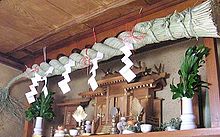
Every industrialized country in the world, excluding the United States, produces industrial hemp including Australia, Austria, Canada, China, Great Britain, France, Russia and Spain.[42]
From the 1950s to the 1980s the Soviet Union was the world's largest producer (3,000 km² in 1970). The main production areas were in Ukraine,[43] the Kursk and Orel regions of Russia, and near the Polish border. Since its inception in 1931, the Hemp Breeding Department at the Institute of Bast Crops (Template:Lang-ru) in Hlukhiv (Glukhov), Ukraine, has been one of the world's largest centers for developing new hemp varieties, focusing on improving fiber quality, per-hectare yields, and low THC content.[44][45]
Other important producing countries were China, North Korea, Hungary, the former Yugoslavia, Romania, Poland, France and Italy.
In Japan, hemp was historically used as paper and a fiber crop; it was restricted as a narcotic drug in 1948. The ban on marijuana imposed by the US authorities was alien to Japanese culture, as the drug had never been widely used in Japan before. There is archaeological evidence that cannabis was used for clothing and the seeds were eaten in Japan right back to the Jōmon period (10,000 to 300 BCE). Many Kimono designs portray hemp, or "Asa" (Template:Lang-ja), as a beautiful plant.
France (8,000 hectares cultivated) is Europe's biggest producer. Canada (9,725 ha in 2004),[46] the United Kingdom, and Germany all resumed commercial production in the 1990s. British production is mostly used as bedding for horses; other uses are under development. The largest outlet for German fibre is composite automotive panels. Companies in Canada, UK, US and Germany among many others process hemp seed into a growing range of food products and cosmetics; many traditional growing countries still continue to produce textile grade fibre.
Hemp is illegal to freely grow in the U.S. and several other countries because the plant is related to marijuana. In such countries, hemp is imported from China and the Philippines. However, industrial growth is legal in North Dakota, Hawaii, Kentucky, Maine, Maryland, Montana and West Virginia.
Industrial growth under licence
Licenses for hemp cultivation are issued in the European Union, Canada, in three states of Australia, and two of the United States.[citation needed]
In the United Kingdom, these licenses are issued by the Home Office under the Misuse of Drugs Act 1971. When grown for non-drug purposes hemp is referred to as industrial hemp, and a common product is fiber for use in a wide variety of products, as well as the seed for nutritional aspects as well as for the oil. Feral hemp or ditch weed is usually a naturalized fiber or oilseed strain of Cannabis that has escaped from cultivation and is self-seeding.
In Australia the states of Victoria, Queensland and most recently New South Wales issue licences to grow hemp for industrial use. Victoria was an early adopter in 1998, and has reissued the regulation in 2008[47]. Queensland has allowed industrial production under licence since 2002[48] where the issuance is controlled under the Drugs Misuse Act 1986[49]. Most recently New South Wales now issues licences[50] under law that came into effect as at the 6th of November 2008, being the Hemp Industry Regulations Act 2008 (No 58)[51].
Vermont and North Dakota have passed laws enabling hemp licensure. Both states are waiting for permission to grow hemp from the Drug Enforcement Agency (DEA). Currently, North Dakota representatives are pursuing legal measures to force DEA approval.Cite error: The <ref> tag has too many names (see the help page).
Future of hemp

Hemp advocates foresee a bright future for hemp. As mentioned earlier, as a health food, hemp has become increasingly popular in America and abroad. Canada has been increasing its crop and exports, although Canada only grows hemp for seed and oil, not fiber. The real future for hemp remains under the surface, and prices remain too high for any significant consumer use.
Hemp laws are being passed around the United States in states such as Kentucky, Vermont and North Dakota. Pro-hemp laws have been passed in a dozen states, five in North Dakota (ND) alone. Under the new ND law, farmers no longer need permission from the DEA to grow industrial hemp, which now is distinguished from "marijuana".[52] ND was very close to its first growing season, but the DEA delayed the applications too late to begin the season.
The bright future exists in the environmental merit of hemp. Hemp is sold alongside organic cotton for clothes and is becoming popular as environmental awareness becomes more prevalent. Hemp has been written about in newspapers and magazines across the country, though few people know about hemp and its various benefits and uses.
Hemp Plastic is a new technology based on 20-100% hemp fiber-based plastics that can be molded or injection molded. Demand for fiber-reinforced composites and other natural plastics could become more popular as oil prices rise and environmental awareness increases.
The increased demand for health food has stimulated the trade of shelled hemp seed, hemp protein powder and hemp oil as well as finished and ready-to-eat food products (waffles, granola bars, ice cream, and milk for example) using these derivatives as ingredients. The use of hemp oil in the manufacture of body care products has also increased.
As a natural fibre, hemp is involved in the International Year of Natural Fibres 2009.
THC in hemp

Hemp contains delta-9-tetrahydrocannabinol (THC), which is the psychoactive ingredient found in hashish and marijuana. While THC is present in all Cannabis plant varieties to some extent, industrial hemp does not contain an amount to produce any intoxicating effect, even in significant quantities. In varieties grown for use as a drug, where males are removed in order to prevent fertilization, THC levels can reach as high as 24% in the unfertilized females which are given ample room to flower. In hemp varieties grown for seed or fibre use, the plants are grown very closely together and a very dense biomass product is obtained, rich in oil from the seeds and fibre from the stalks and low in THC content. EU and Canadian regulations limit THC content to 0.3% in industrial hemp.
On October 9, 2001, the US Drug Enforcement Administration (DEA) ruled that even traces of THC in products intended for food use would be illegal as of February 6, 2002. This Interpretive Rule would have ruled out the production or use of hempseed or hempseed oil in food use in the USA, but after the Hemp Industries Association (HIA) filed suit the rule was stayed by the United States Court of Appeals for the Ninth Circuit on March 7, 2002. On March 21, 2003, the DEA issued a nearly identical Final Rule which was also stayed by the Ninth Circuit Court of Appeals on April 16, 2003. On February 6, 2004, the Ninth Circuit Court of Appeals issued a unanimous decision in favor of the HIA in which Judge Betty Fletcher wrote, "[T]hey (DEA) cannot regulate naturally-occurring THC not contained within or derived from marijuana—i.e. non-psychoactive hemp is not included in Schedule I. The DEA has no authority to regulate drugs that are not scheduled, and it has not followed procedures required to schedule a substance. The DEA's definition of "THC" contravenes the unambiguously expressed intent of Congress in the Controlled Substances Act (CSA) and cannot be upheld." On September 28, 2004, the HIA claimed victory after DEA declined to appeal to the Supreme Court of the United States the ruling from the Ninth Circuit Court of Appeals protecting the sale of hemp-containing foods. Industrial hemp remains legal for import and sale in the U.S., but U.S. farmers still are not permitted to grow it.
Strong opposition to trace amounts of THC, a chemical shown by scientific research to be less harmful[citation needed] and less addictive [53] than nicotine or alcohol, leads some of its critics, like Jack Herer in The Emperor Wears No Clothes, to charge ulterior motives such as protection of the synthetic-fibre, wood pulp, petrochemical, and pharmochemical industries. The US government's position has not been completely constant, as shown by the wide-spread cultivation of industrial hemp in Kentucky and Wisconsin during World War II.[54] Critics of the HIA [who?], however, argue that the necessities of the war and the unavailability of adequate synthetic substitutes outweighed the social, health, and public safety risks of producing hemp.
The presence of THC in hemp varieties and the fear that fields with hemp can hide cultivation of cannabis with more THC has hampered the development of hemp in many countries, most notably, the United States. Regulations in certain countries in EU demand approved variety of the seed and registration of the field in advance every year.
Marijuana is often female only, and kept completely isolated from any males, to keep the THC production up and seed production low. There are specially developed strains that require a very specific growing operation, and there is much care put into increasing THC production. Hiding marijuana in a hemp field would create a variety of problems. One is, the dense hemp would most likely "choke out" the marijuana, taking valuable and necessary nutrients and sunlight that the marijuana needs to produce THC. Even more, the male hemp plants would fertilize the marijuana plants, which would have several side effects. First, the marijuana would produce seeds, quickly lowering its value. Energy growing seeds quickly diminishes THC content. More importantly, the fertilization essentially crossbreeds the hemp and marijuana (only in the THC potent females). While the hemp will not produce any more THC, the marijuana, once "tainted" by the Hemp, will produce significantly less THC, depending on how long and how close the contact is with the Hemp.
If marijuana was successfully hidden and grown in a hemp field, the resulting plant matter would be of very little street value. It would be full of seeds and stems (because of fertilization), be malnourished (because hemp, like a strong weed, sucks up nutrients and grows taller, taking the available sun), and above all, have a very low THC content, making it undesirable to even the indiscriminate marijuana users. There is a consensus between experts and marijuana growers alike[who?]; the risk to reward ratio is too far out of proportion for it to even be considered.[citation needed]
See also
References
- ^ "Ecofibre Industries Limited - Facts About Hemp".
- ^ "Information paper on industrial hemp (industrial cannabis)". www2.dpi.qld.gov.au. Retrieved 2008-07-05.
- ^ "HIA: Resources: Education: FAQs & Facts: Facts". www.thehia.org. Retrieved 2008-07-05.
- ^ "HIA: Resources: Education: FAQs & Facts: FAQs: Answers". www.thehia.org. Retrieved 2008-07-05.
- ^ http://www.hemphasis.net/Paper/paper_files/hempvtree.htm
- ^ "Erowid Cannabis Vault : Culture #2". www.erowid.org. Retrieved 2008-06-20.
- ^ http://www.ratical.org/renewables/hempseed1.html
- ^ "Living Harvest - The Official Website & Online Store - Hemp Seed Nutrition - Unearthing the Benefits of Hemp Seed". www.worldpantry.com. Retrieved 2008-07-27.
- ^ Welcome To The Cool Hemp Company
- ^ a b http://www.ers.usda.gov/publications/ages001E/ages001Eh.pdf
- ^ Callaway JC (2004). Hempseed as a nutritional resource: an overview. Euphytica 140:65-72.
- ^ Schwab U, Callaway J, Erkkilä A, Gynther J, Uusitupa M, Järvinen T (2006). Effects of hempseed and flaxseed oils on the profile of serum lipids, serum total and lipoprotein lipid concentrations and haemostatic. European Journal of Nutrition 45(8):470-7.
- ^ Callaway, JC, Schwab U, Harvimaa I, Halonen P, Mykkänen O, Hyvönen P & Järvinen T (2005). Efficacy of dietary hempseed oil in patients with atopic dermatitis. Journal of Dermatological Treatment 16: 87-94.
- ^ HNAIHC Hemp Facts
- ^ CRRH, Archaeologists agree that cannabis was among the first crops cultivated by human beings at least over 6,000 years ago, and perhaps more than 12,000 years ago
- ^ Online Etymology Dictionary
- ^ a b Gertjan van Roekel jr.:Hemp Pulp and Paper Production
- ^ Dewey and Merrill, U.S.D.A. Bulletin No. 404, Washington, D.C., October 14, 1916. Page 25
- ^ "The Emperor Wears No Clothes". www.jackherer.com/. Retrieved 2007-04-02.
{{cite web}}: External link in|publisher= - ^ Finchem, Kirk J: Mills explore capacity options to extend recovery boiler life, Pulp & Paper, Feb 1997
- ^ ECF: The Sustainable Technology
- ^ Peter Ince:Technological Flexibility in the North American Forest Sector World Forests, Society and Environment, Edited by Matti Palo and Jussi Uusivuori 1999
- ^ H.T. NUGENT:COMMERCIALIZED HEMP (1934-35 CROP) in the STATE OF MINNESOTA
- ^ a b "Additional Statement of H.J. Anslinger, Commissioner of Narcotics". Retrieved 2006-03-25.
- ^ Search Results - The Huffington Post
- ^ Marijuana Timeline
- ^ [1]
- ^ [2] since 1992
- ^ Hemp is considered a prohibited noxious weed. "HEMP AS WEED CONTROL". www.gametec.com. Retrieved 2008-07-09.
- ^ "The Truth Seeker - The Marijuana Trick". www.thetruthseeker.co.uk. Retrieved 2008-07-06.
- ^ Hemp 4 Fuel - Clean Energy Solutions
- ^ Hempcar.org-Pollution: Petrol vs Hemp
- ^ Hempcar.org-Biofuels Facts
- ^ Jack Herer - Chapter 9
- ^ a b Stafford, Peter. 1992. Psychedelics Encyclopedia. Berkeley, California, Ronin Publishing, Inc. ISBN 0-914171-51-8
- ^ Regional Cuisines of Medieval Europe: A Book of Essays (2002), edited by Melitta Weiss Adamson ISBN 0-415-92994-6 pg. 98, 166
- ^ a b "Feasibility of Industrial Hemp Production in the United States Pacific Northwest, SB681". extension.oregonstate.edu. Retrieved 2008-06-18.
- ^ Gabriel Archer, A Relatyon of the Discoverie of Our River..., printed in Archaeologia Americana 1860, p. 44.
- ^ Proceedings of the Virginia Assembly, 1619, cf. the 1633 Act: Hening's Statutes at Large, p. 218
- ^ "Hemp Info". altahemp.com. Retrieved 2008-06-12.
- ^ James F. Hopkins, Slavery in the Hemp Industry
- ^ "Hemp vs. Marijuana". azhemp.org. Retrieved 2008-06-18.
- ^ Hemp research and growing in Ukraine
- ^ Hemp will help Ukraine to grow wealthy Template:Ru icon
- ^ Interview with Dr. V. G. Virovets, the head of the Hemp Breeding Department at the Institute of Bast Crops (1998) Template:En icon
- ^ [3]
- ^ "Drugs, Poisons and Controlled Substances (Industrial Hemp) Regulations 2008" (PDF). www.dms.dpc.vic.gov.au. Retrieved 2008-11-24.
- ^ "Guidelines for engaging in the commercial production of industrial hemp in Queensland". dpi.qld.gov.au. Retrieved 2008-11-24.
- ^ "Drugs Misuse Act 1986" (PDF). www.legislation.qld.gov.au. Retrieved 2008-11-24.
- ^ "Opportunities to engage in commercial low THC hemp fibre and seed production in NSW". www.dpi.nsw.gov.au. Retrieved 2008-11-24.
- ^ "Hemp Industry Regulation 2008". legislation.nsw.gov.a. Retrieved 2008-11-24.
- ^ Industrial Hemp Information and Advocacy - Vote Hemp
- ^ Which drugs are the most addictive?
- ^ Hemp for Victory, Kentucky Hemp News
External links
This article's use of external links may not follow Wikipedia's policies or guidelines. |
General
- Information on industrial cannabis
- Plant Cultures: hemp botany, history, uses
- Read Congressional Research Service (CRS) Reports regarding Hemp as an Agricultural Commodity
- The Emperor Wears No Clothes
- Hemp Museum at US Hemp Co
- History of Hemp Paper Brief History of Hemp Paper
- [6] Hempology.org - The study of hemp from a historical perspective
- Scannabis.com - Cannabis News and Reports
- The HempFarm.org Hemp History and Information
- King's College Report Review of Nutritional Attributes of Cold Pressed Hemp Seed Oil
Hemp industry
- Articles needing cleanup from January 2008
- Cleanup tagged articles without a reason field from January 2008
- Wikipedia pages needing cleanup from January 2008
- Articles with specifically marked weasel-worded phrases from August 2008
- Hemp
- Cannabis
- Energy crops
- Fiber plants
- Fodder
- Medicinal plants
- Underutilized crops
